
Browse an alphabetical list of photographs. These historical images portray people, places, and events before, during, and after World War II and the Holocaust.
<< Previous | Displaying results 726-750 of 2641 for "Photo" | Next >>
Deportation of Jews from Skopje, Yugoslavia, March 1943. The Jews of Bulgarian-occupied Thrace and Macedonia were deported in March 1943. On March 11, 1943, over 7,000 Macedonian Jews from Skopje, Bitola, and Stip were rounded up and assembled at the Tobacco Monopoly in Skopje, whose several buildings had been hastily converted into a transit camp. The Macedonian Jews were kept there between eleven and eighteen days, before being deported by train in three transports between March 22 and 29, to Treblinka.
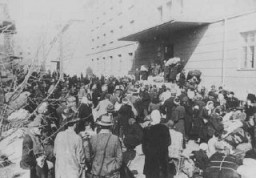
Deportation of Slovak Jews. Stropkov, Czechoslovakia, May 21, 1942.
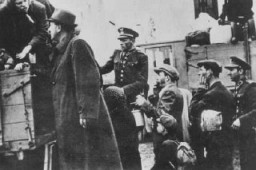
Jews from the Lodz ghetto are loaded onto freight trains for deportation to the Chelmno killing center. Lodz, Poland, 1942–44.
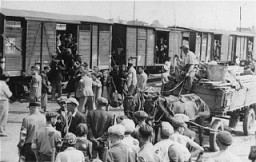
Scene during the deportation of Jews from Thrace to the Treblinka killing center. Lom, Bulgaria, March 1943.
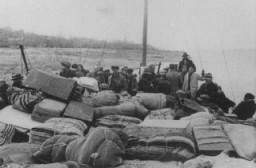
Deportation of Jews from the Warsaw ghetto. Jews from the ghetto board a deportation train with the assistance of Jewish police. Warsaw, Poland, 1943.
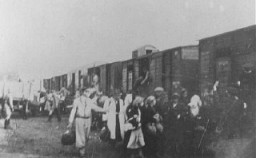
A family of Macedonian Jews carries their luggage down a flight of stairs as they leave the Tobacco Monopoly transit camp for the deportation trains. Skopje, Yugoslavia, March 1943.
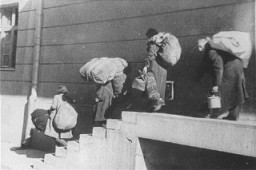
Scene during the deportation of Macedonian Jews by Bulgarian occupation authorities. Skopje, Yugoslavia, March 1943.
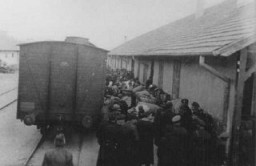
Serbs and Roma (Gypsies) who have been rounded up for deportation. This photograph shows them being marched to Kozare and Jasenovac, both Croatian concentration camps. Yugoslavia, July 1942.
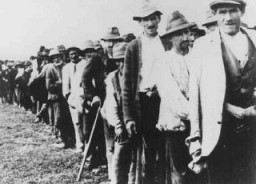
Deportation of Slovak Jews. The victims wear tags and are escorted by Slovak guards. Czechoslovakia, ca. 1942.
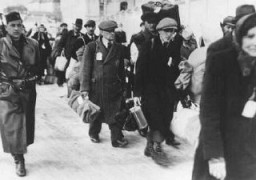
Jews are forced into boxcars for deportation to the Belzec killing center. Lublin, Poland, 1942.
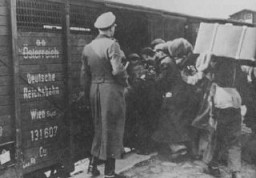
Jews carrying their possessions during deportation to the Chelmno killing center. Most of the people seen here had previously been deported to Lodz from central Europe. Lodz, Poland, January–April 1942.
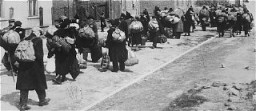
Serbs and Roma (Gypsies) who have been rounded up for deportation are marched to the Jasenovac concentration camp under Ustasa guard. Yugoslavia, 1942–43.
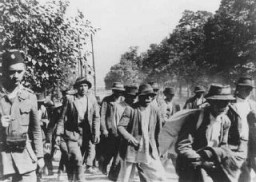
Jewish deportees marching down a main street of Koszeg during the deportation of Hungarian Jews. Koszeg, Hungary, May 1944.
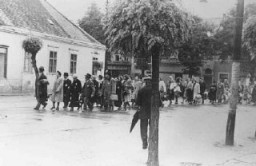
Deportation of the last Jewish inhabitants of Hohenlimburg, the Lowenstein and Meyberg families. Germany, April 23, 1942.
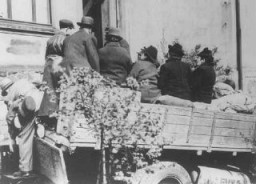
A long line of people waiting to be fed in New York City.
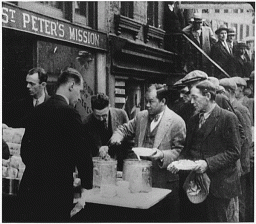
Unemployed men queued outside of a depression soup kitchen in Chicago.
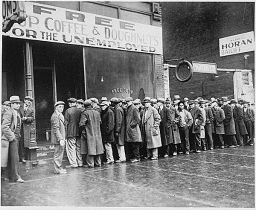
German children, behind an SS man, watch as religious objects from the Zeven synagogue are set on fire during Kristallnacht (the "Night of Broken Glass"). Zeven, Germany, November 10, 1938.
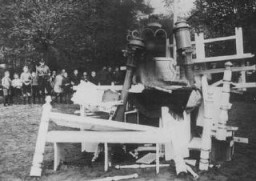
The holy ark in the sanctuary of the Seitenstetten Street synagogue, demolished during Kristallnacht (the "Night of Broken Glass"). Vienna, Austria, after November 9, 1938.
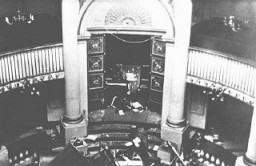
A deserted street in the area of the Sighet Marmatiei ghetto. This photograph was taken after the deportation of the ghetto population. Sighet Marmatiei, Hungary, May 1944.
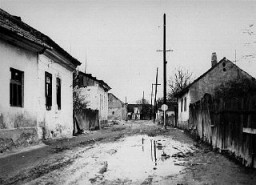
Party scene from the early 1940s in Germany. In the foreground is Deska Garber. Deska’s father was Joseph Garber, a Togolese man, and his mother was Johanna Maychrzak, a white German woman. The woman in the back left is Else Hummel, whom Deska would marry after the war. A small portrait of Adolf Hitler is visible on the wall in the background, something that would have been very common in German homes during the Nazi era.

A Warsaw ghetto resident gives money to two children on a Warsaw ghetto street. Warsaw, Poland, between October 1940 and April 1943.
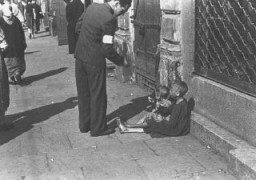
View of the smoldering ruins of a building in Warsaw following a German aerial attack. Warsaw, Poland, September 1939.
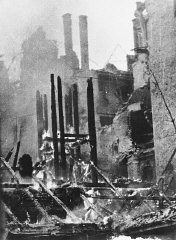
View of the destroyed Jewish cemetery in German-occupied Salonika. The tombstones would be used as building materials. Salonika, Greece, after December 6, 1942.
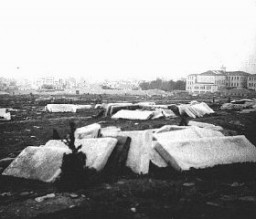
The ruins of a synagogue destroyed by the Germans in 1943. The synagogue, originally built in 1853, was rebuilt after the war with the help of the American Jewish Joint Distribution Committee. Volos, Greece, 1944.
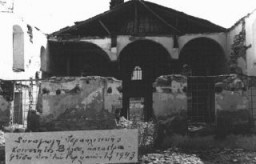
German soldiers burn residential buildings to the ground, one by one, during the Warsaw ghetto uprising. Poland, April 19-May 16, 1943.
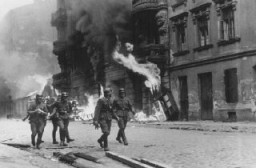
We would like to thank Crown Family Philanthropies, Abe and Ida Cooper Foundation, the Claims Conference, EVZ, and BMF for supporting the ongoing work to create content and resources for the Holocaust Encyclopedia. View the list of donor acknowledgement.